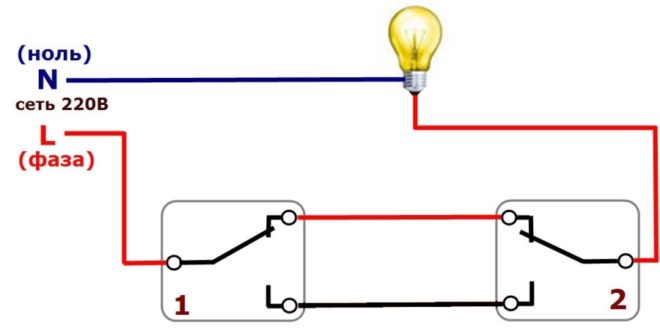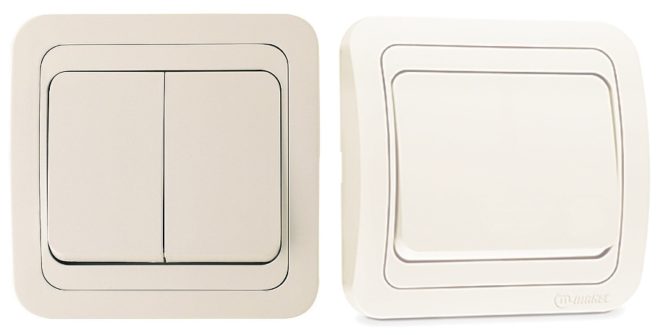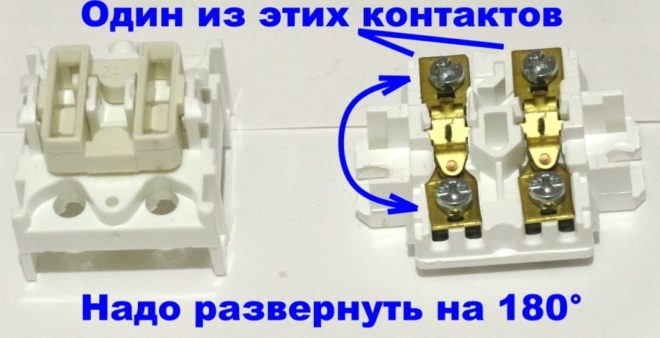How to make a pass-through switch with your own hands from a conventional

A pass-through switch is a device with which you can control one light source from different places. These devices are installed in long corridors, as well as in passages and stairs. Recently, they have been increasingly used in bedrooms: one switch is at the entrance to the room, and the second is near the bed. Their convenience lies in the fact that in order to turn off the light in the hallway or room, there is no need to return. They are also used in offices: in this case, sitting down at the table and turning on the table lamp, you can turn off the upper lamp without getting up from your workplace. This article will discuss how to make a pass-through switch from an ordinary one yourself.
Content
Features of the pass-through switch
Unlike a conventional double switch, the bushing has three contacts. These devices are connected to each other by means of a three-core cable, which can pass openly from the outside, or can be hidden inside the wall in a grooved groove.
The connection is carried out in such a way that the neutral wire goes to the light source, and the phase goes to the circuit breaker to the switch. The zero cable goes through the electrical distribution box to the lamp, the phase to the input.

Two cables are connected to the output, and by means of a jumper, the electrical circuit is alternately closed. These wires are connected to the second switch, and one of them goes further, to the luminaire. Thus, the transfer of electricity from the first line to the second is carried out.
A device such as a triple pass-through switch is available on the market today, but its cost is quite high. And if you do not have a desire to overpay a lot of money, you can make a pass-through switch with your own hands. This does not require any special tool or any special professional skills.
Externally, the pass-through switch is indistinguishable from a conventional one, and may have one or more switching keys. The difference between them lies in the internal structure. At home, marching switches with one key are usually used. However, it is more correct to call the adapter a switch, since it is intended for switching electrical circuits. If the room is large, a multi-key fixture may be needed.
Alteration: Procedure
Recycling a conventional switch in the bushing is to add a third contact. For this operation, it is desirable for us to have two switches made by the same manufacturer: one and two keys.

They should not differ in size from each other. When buying a two-key device, you need to pay attention to whether it is possible to swap the terminals in such a way that the closure and opening of each circuit occurs independently of the other. Thus, one of the positions of the switch key will correspond to the inclusion of the first circuit, the other - the second.
Now we go directly to the work itself on the alteration of the device:
- We loosen the clamps of the suitable cables, as well as the screws of the spacer spacers - this is necessary in order to pull the switch out of the socket in the wall. Naturally, the electricity must be turned off. It is also advisable to locate the phase with a probe and make the appropriate marks on the plastic insulation of the wire. This will make it as easy as possible to re-install the fixture.
- After removing the switch, turn it over to the opposite side, unbend the body clamps and remove the electrical part. With a regular screwdriver, this can be done in two to three minutes. Then, with a thick slotted screwdriver, take out the spring pushers located in the bed. You cannot do this with a thin screwdriver. When removing the pushers, be careful and take your time so as not to break or bend the elements.

- There are two teeth on the ends of the dismantled part of the switch - they must be pry off with a slotted screwdriver.
- We pass to the main stage of the procedure. On a ceramic basis, the device has three groups of contacts: general, individual and movable (rocker arms). One of the rocker contacts must be turned 180 degrees, after which one contact pad belonging to the general group must be cut off (after that it is not necessary to isolate). After that, the previously removed part of the product is installed in place.

- Then the key from the single switch is removed and installed on the converted two-key device. If you do not have a single switch, you can glue the two buttons together. The easiest way to do this is with a special pistol. Now, when the contacts of one circuit are closed, the other will hang in the air.
As you can see from the above, the procedure is quite simple and will not take much of your time.
Disadvantages of pass-through switches
It should be noted that these devices, due to their specificity, have small disadvantages:
- It is impossible to determine whether the device is turned off or on by the arrangement of its keys.
- Do not turn on or off the lamp at the same time from different places.
These minor drawbacks do not affect the operation of the device in any way and can hardly affect the decision to install them or make it yourself, but you must be prepared that some confusion may arise at first after installing the switch.
The process of altering a conventional switch in a checkpoint is clearly visible in the video:
If you do not want to disassemble the switch, then the next video shows a direct connection method. It is not as effective as the first, but as an option in case of emergency it can be useful:
Conclusion
A walk-through switch, either store-bought or self-made, is a very handy device. Turning the light on and off from different locations avoids having to go back and forth from one end of the room to the other just to click a key.
In this material, we figured out in detail how you can remake a conventional switch in a checkpoint. With a certain skill, you will not only save your finances, but you yourself will make a completely workable and neat switch, which is practically in no way inferior to the factory one. It can be used in the same way as a factory product. And not everyone can boast of having such a homemade device in their home, so for you this will be an additional reason to be proud of yourself.




